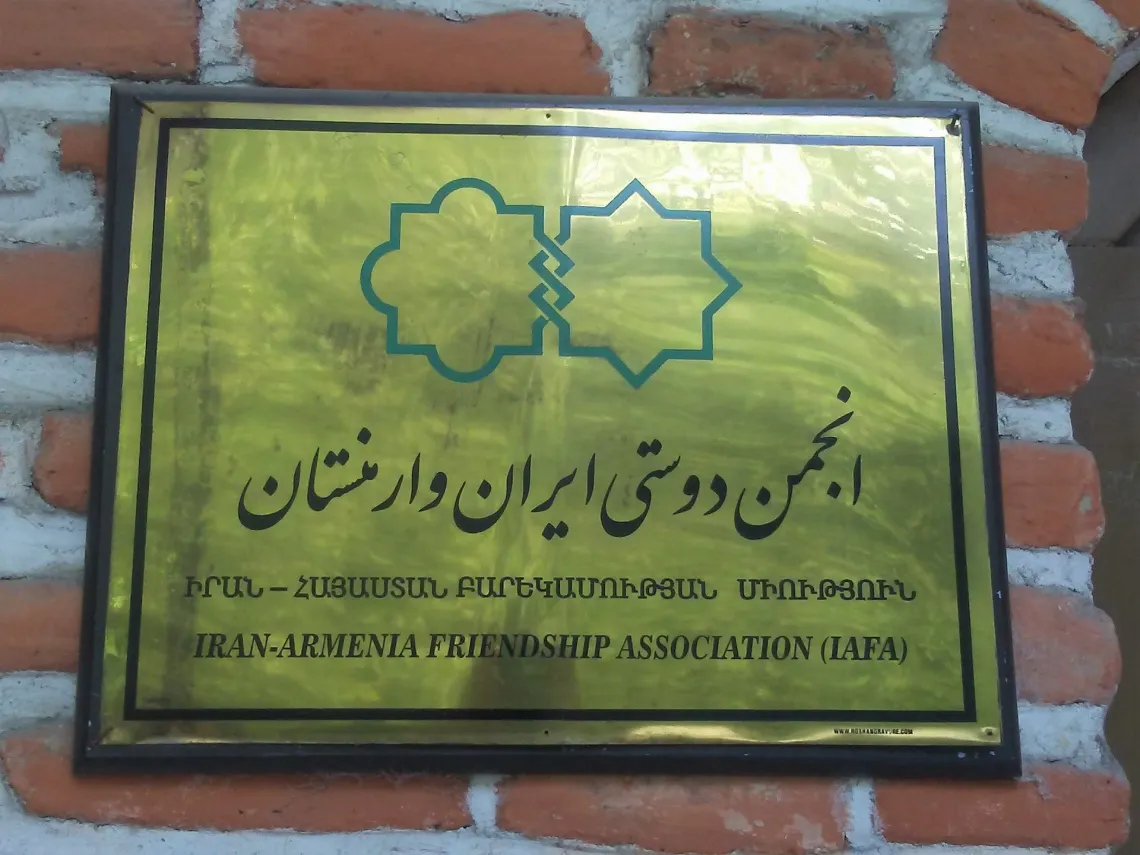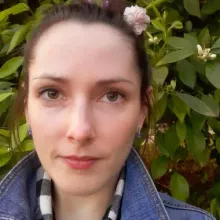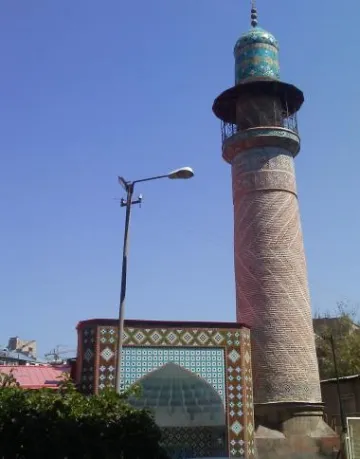First Graduate of the Roshan Graduate Interdisciplinary Program in Persian and Iranian Studies Examines Iranian-Armenian Relations

Iran-Armenia Friendship Association plaque
This summer, the Roshan Graduate Interdisciplinary Program in Persian and Iranian Studies at the University of Arizona celebrates Robin Brackett, its first graduate. For her master’s thesis, Brackett examined 300 years of friendly Iranian-Armenian relations through the memories, nationalism and shifting identities around the Blue Mosque of Yerevan.
Brackett’s thesis advisor, Anne H. Betteridge, Director of the UArizona Center for Middle Eastern Studies, remarked that the Roshan GIDP attracts excellent students. “Robin Brackett is distinguished as an M.A. student for her creative research related to Iran in Armenia,” Betteridge said. “She approaches her studies and her research with intelligence, excitement, and uncommon grace. I value her truly interdisciplinary approach to her work, with its attention to Persian language, material culture, and political relationships.”

The Persian and Iranian Studies Program, offered by the School of Middle Eastern and North African Studies, stands out as one of the strongest and largest in the nation. In a long-standing relationship with Roshan Cultural Heritage Institute, the program has received nearly $3.5 million since 2003.
A grant from the institute in 2016 helped create the Roshan Graduate Interdisciplinary Program in Persian and Iranian Studies, which is housed in the Graduate College. Elahé Omidyar Mir-Djalali, Founder and Chair of Roshan Cultural Heritage Institute, said that one of the goals of the program is to create a pipeline of Persian and Iranian Studies scholars and Persian language teachers.
“Dr. Mir-Djalali’s big goal was to bring Persian and Iranian Studies to the forefront in this country,” said Virginia Healy, senior director of development in the College of Social and Behavioral Sciences. Healy added that the institute’s gifts to UArizona have focused on graduate student training and support.
Ultimately, the University of Arizona serves as a platform to elevate the country’s production of Iranian and Persian Studies experts who have the linguistic expertise, as well as the tools, to work creatively in a variety of fields that allow them to pursue new paths of research.
Brackett, who stands out for her superior Persian language skills and her ability to work across disciplines, is an example of the strong experts that the program can produce.
“Brackett’s work epitomizes the selfless efforts of many members of the university in establishing an excellent and prestigious program,” said Kamran Talattof, who served on Brackett’s thesis committee and holds the Elahé Omidyar Mir-Djalali Chair in Persian and Iranian Studies. Talattof, the founding Chair of the program, brought the grant to the University of Arizona in 2016. He says the program will have two more MA graduates by the end of this summer.

Brackett fell in love with Persian calligraphy 20 years ago, during her years as a painting and art history student at The University of Colorado. She was charmed by handwritten calligraphy and the rich ornaments and Kufic inscriptions in mosques. She learned how to write the alphabet and hired a Persian tutor. She has been studying the language ever since. What started as a visual appreciation evolved into a real passion to understand the complexity of Iranian Studies and the ways of foreign affairs. In 2015, as the Iranian nuclear deal was signed, Brackett enrolled for a program in International Studies and Persian Language at Portland State University.
Even though it was U.S.-Iranian relations that attracted her to political sciences, Brackett wants to fill the gaps in other important areas of foreign affairs that are left unnoticed. “The relationship between Iran and Armenia is far less studied, although it is very interesting,” she said. “I think it’s important to have a good example of friendly relationships. A lot of people just automatically think of Iran as this antagonistic country.”
Studying the Blue Mosque in Yerevan while at the University of Arizona gave Brackett an opportunity to delve into this relationship. Built in 1765, it stands as a symbol of multiculturalism and religious tolerance; it is the only active mosque left in Armenia. “Most religious monuments were torn down in the Soviet era,” Brackett said. “The fact that this mosque survived is pretty amazing.”
Brackett had never seen an Iranian mosque and Yerevan was as close as she could get. “It was great to see the real thing, instead of the pictures in books,” she said. She describes the tile work of the “gorgeous dome” and the muqarnas in the alley paths — a honeycomb-shaped vault traditional in Islamic architecture.
“I think my main source of brainfood is visual culture,” said Brackett. “I really gravitate towards the visual culture of Iran.”
Brackett’s research presents a rich and complex interweaving of disciplines and lenses to understand foreign affairs. In fall 2020, she will join the University of Oregon as a Ph.D. student of Political Sciences, where she will continue to produce knowledge about the Iran-Armenia relationship. She said she will work with faculty experts on political economy, adding her own sociological observations.
“The relationship between Iran and Armenia is mutually beneficial,” said Brackett. “I want to understand more about how Armenia justifies doing business with such a heavily sanctioned country when it brings problems for themselves.”
Brackett’s expertise and passion embody the sustained efforts of Iranian and Persian Studies faculty and the contributions of the Roshan Graduate Interdisciplinary Program in Persian and Iranian Studies to the University of Arizona’s mission: to produce knowledgeable and versatile researchers who can lead the way in area studies with deep political, cultural, and linguistic understanding.

